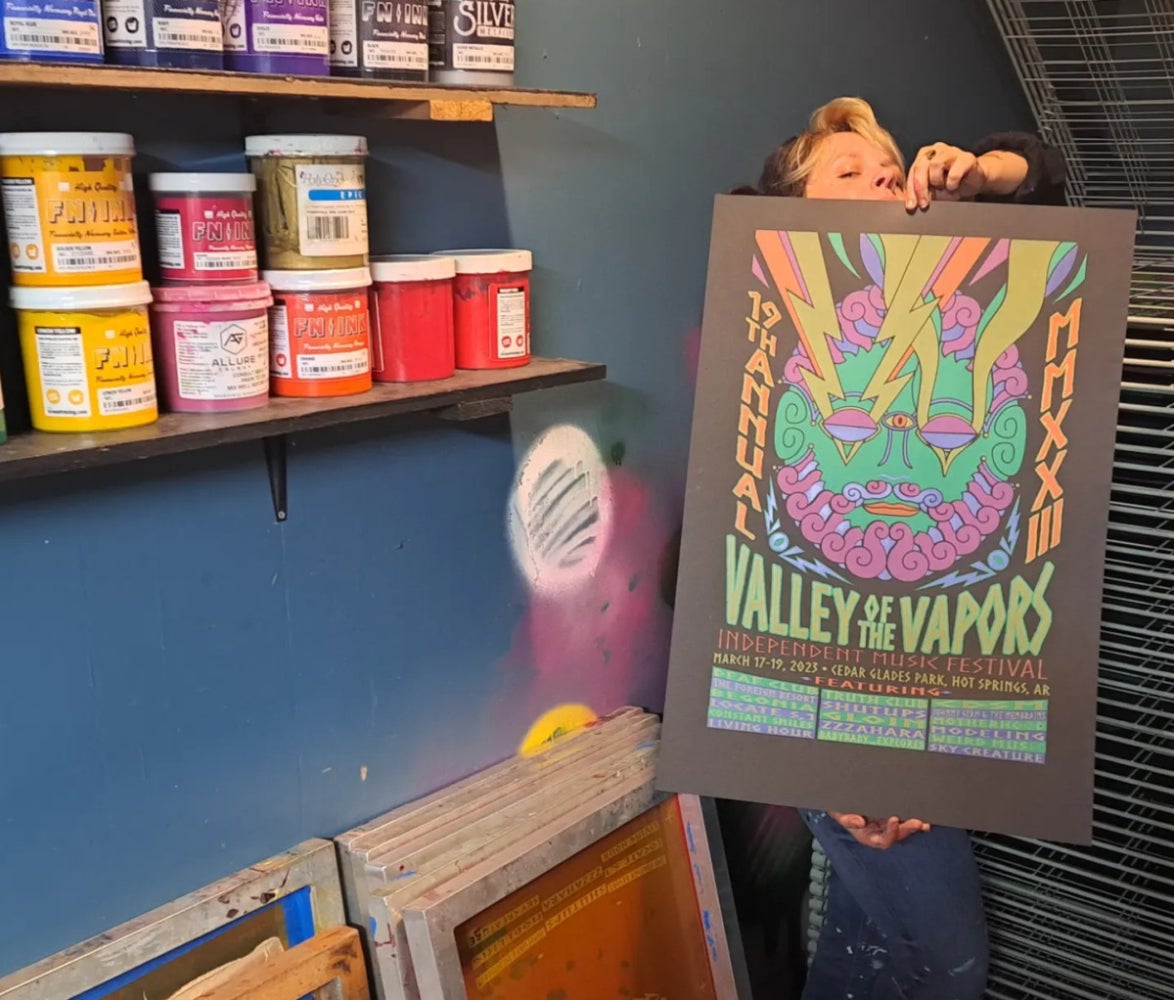
Dedicated Visual Art Studio and Gallery is a community gathering space in Levy: a small, low-income neighborhood in North Little Rock, Arkansas. Levy is comprised of a series of single-family homes, hole in the wall restaurants, and a buzzing, expressive community. Dedicated Visual Art Studio sits in the middle of this, next door to a Dollar General, across the street from a Valero, and down the street from Arkansas’ biggest used record store. More than just a gallery space or studio for work, Dedicated regularly hosts DIY workshops, local punk bands, and artist vendors.
On March 31st, 2023, up to 145 tornadoes broke out across the Southern and Eastern United States, bulldozing over thirty-four miles in Central Arkansas in less than an hour.[1] Dedicated Visual Art Studio is still standing, but not without damage. As of June, many businesses in the Levy/Amboy area are still in disrepair or without electricity.
Eight days after the tornado hit, Dedicated hosted the first event of what will be a summer full of events. In the back office space of their studio, I sat with Dedicated’s owner and muralist Jose Hernandez and his partner Syd Carmichael to talk about an artist’s responsibility to community and the importance of art to perseverance. Our conversation has been edited for length and clarity.
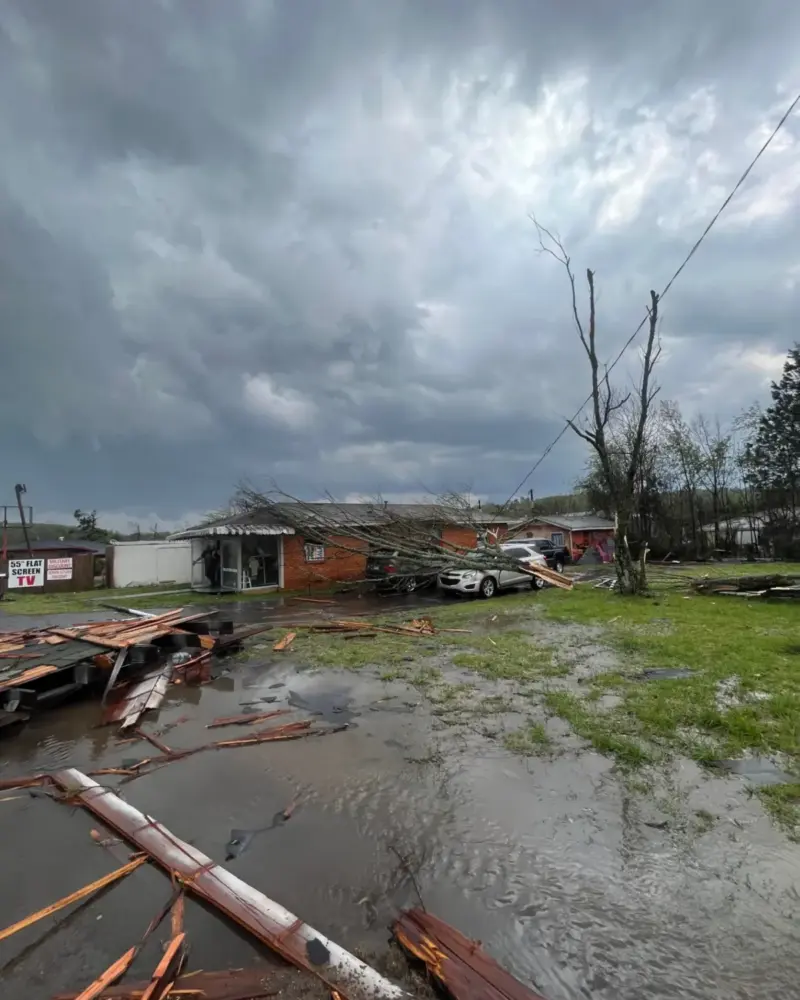
Bianca Littlepage: I want to talk about the tornado that came through here. I was talking to a printmaker friend of mine who was going to be in your show, and I asked her how she’s doing, and she said to me that the gallery was hit, but that you’d still have the show. “It’ll just be a bit more grunge-y” she laughed, and I knew I had to talk to you! What made you decide to hold the pop-p exhibition?
Jose Hernandez: We knew no one was gonna help; so, we’re out here the next day cleaning up. I looked at Syd and my brother, thinking this is gonna take months to clean up. I mean, we got lucky. We’re fine, our home down the street is fine, our equipment in the studio is all fine.
Syd Carmichael: At the cleanup, so many people showed up. So many people from the community just showed up with love, with food, with tools, and just got straight to it.
JH: They didn’t even say hello, they just got started working! My parents brought food for everybody, and the support really restored our faith. We were kind of crushed because we were here when it hit. We got in the back studio room, under the table. All the windows broke, and all you could hear was this whooshing. It felt like it went on for minutes, but it was really only seconds. Then it was completely silent. We stepped outside, and the atmosphere still felt electric, but everything was so still. The ground was, like, breathing. Our fence is gone. The hotel, our neighbors, is destroyed. The guy comes out and gives us a thumbs up to see if we’re ok. It was surreal. I remember just walking around. I started picking up random trash. I didn’t know what to do. It was pointless. I’m trying to put this tarp on the window, but it’s still raining. It is just the need to do something because you can’t do anything. Anything to keep your mind sane.
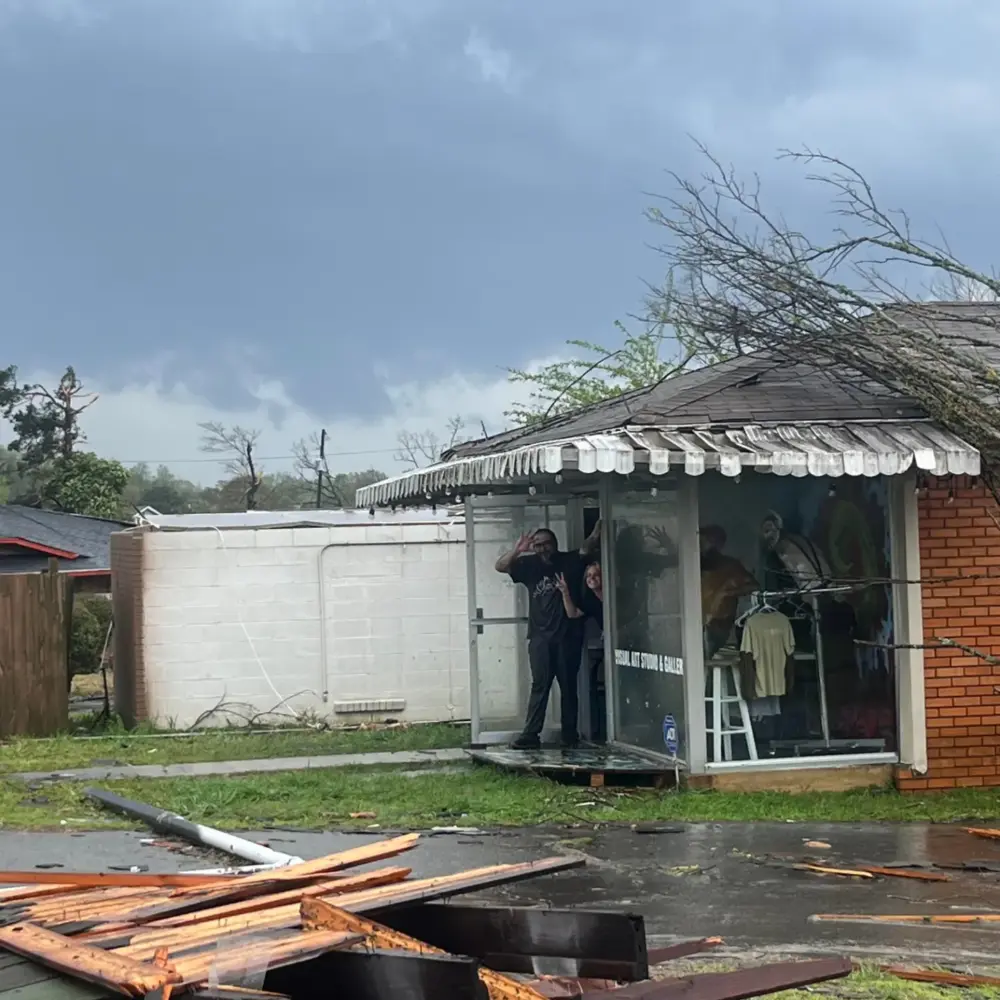
We go home. We get to go home. My parents’ neighborhood got hit. We come back the next day, we start looking around. Our hearts are broken. But people just immediately start helping. The people that we see every day that we don’t know well, like the people at the gas station, they start helping.
And we had this event the next weekend and there was just no way we could cancel.
SC: The way people were showing up for us, there was no way we were gonna cancel it. Why not have a cool event amongst all of this, a reminder.
JH: We keep having events, and they keep getting better and better. We got electricity back last week. We have been having events, running on our generator. We just got our roof fixed on Thursday.
SC: One of our friends said it was ‘twice as Punk’. “Generator show? Twice as Punk! Fuck yeah!!”
BL: This gallery hasn’t always been based out of Levy. You used to be in Little Rock. How has it been having a gallery across the river?
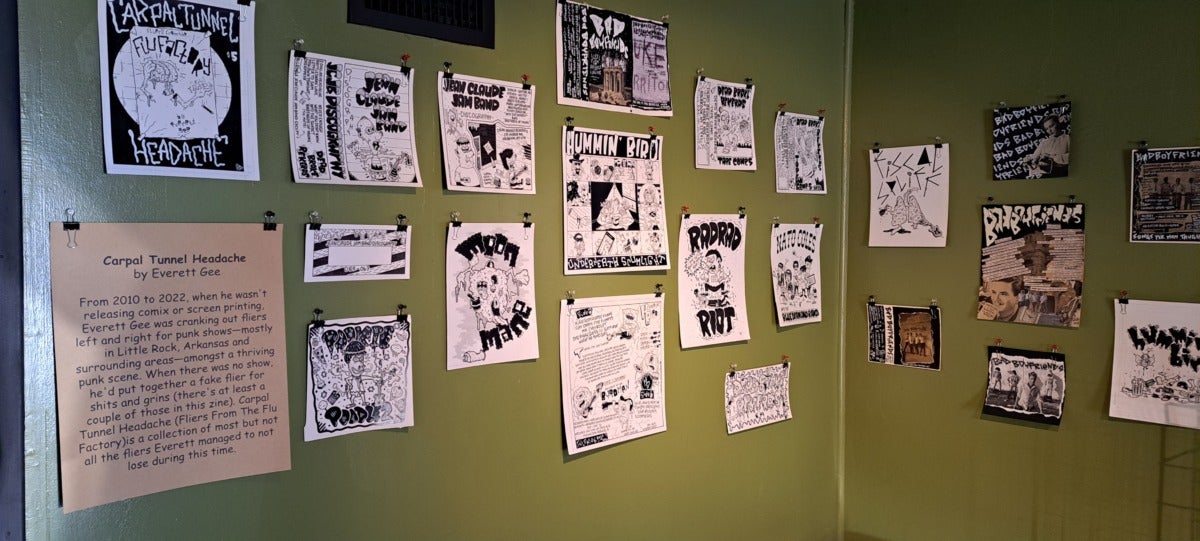
JH: Dedicated started out in 2012, in Little Rock. I rented a theater/warehouse in Little Rock that used to be a printing press. When I opened it up, I had a gallery and two half-pipes inside. We lasted for about six months before the city shut it down. We got voted “Best Arkansas Playground” by the Democrat-Gazette.
We’ve been in Levy for about five years.When I first opened, we had a Fluke zine show. We had 200 people in that small room out front, and some people outside. We got fifty artists to paint fifty skateboards from Paige Boards, that skate shop up the road that has been serving the community since the 80s. We had Fluke’s zines, some bands, and all these skateboards. It was a huge event. When COVID hit we shut down, but we started doing live feeds. I had a DJ friend, or some bands who would come in, and I would paint for hours. Sometimes we streamed artist conversations. When everything opened back up again, I had become a little burned out, so I started focusing on painting murals.
BL: There aren’t many studios or galleries around here.
JH: Yeah, everybody wants to go Downtown to South Main, to Argenta. That’s a big reason why we’re here.
SC: It’s just nice to bring some life back here. We live in the ‘hood; we work in the ‘hood. And we love it. I don’t think people realize how cool it is over here.
The first event we really had here after the Fluke show was that pop up exhibition after the tornado.
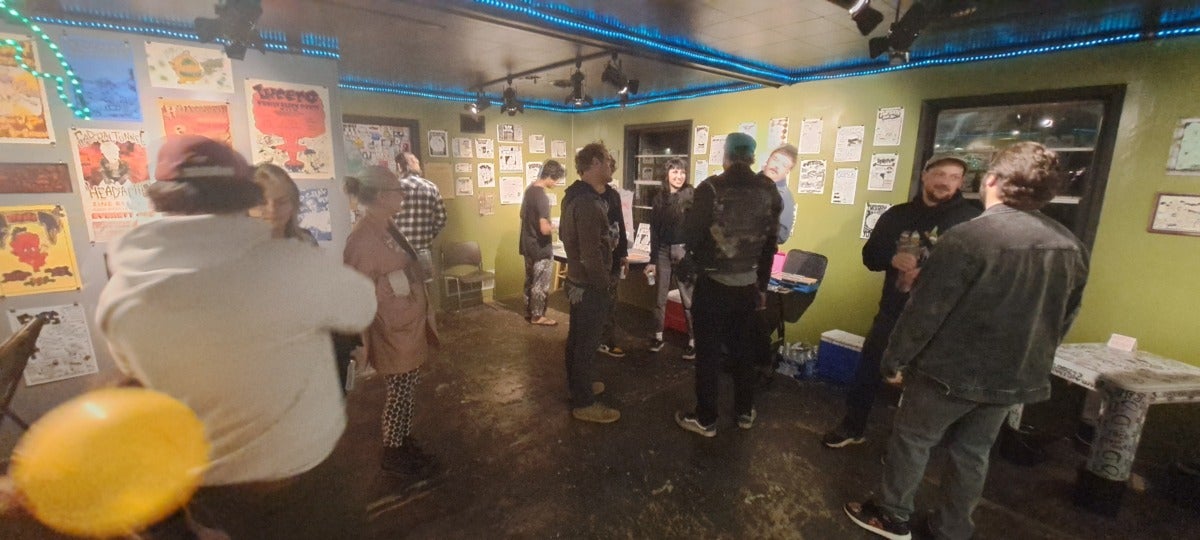
BL: All these recurring events you’ve held at Dedicated, the artist live streams and these hybrid exhibits/concerts, they’ve all emerged out of a time of tragedy or community need. Have art and community always been so interconnected for you?
JH: I’ve always been into art, ever since I was a little kid. I’m an immigrant from Mexico, moved to Jonesboro, AR, in ‘93. I was translating a lot and seeing the struggles of my community. I was translating at community meetings at a trailer park. They were getting a lot of break-ins, because a lot of the residents were undocumented and couldn’t put their money in the bank, so everyone knew they had cash. They couldn’t call the cops, and there was a lot of insecurity in the area because it wasn’t well lit, and it was overgrown: no one likes trailers. So, my idea was to paint murals: we talk to the residents, find out what they like, their stories, and then paint something related to that. That gives them pride in where they live, maybe they want to light it up and there’s more pride. That’s what I see when I paint a mural in an area people are afraid of. You paint a mural, and people take pride in their area again.
BL: You have been a part of so many different opportunities and your career keeps getting bigger. You’re able to fund these projects with your work as a professional artist, but also are now getting opportunities with bigger funding pools.
JH: We aren’t trying to make money from the people who are a part of our events. We make money from our studio, from screen-printing and from murals. We want to do what we love to do, and people need a space to do it.
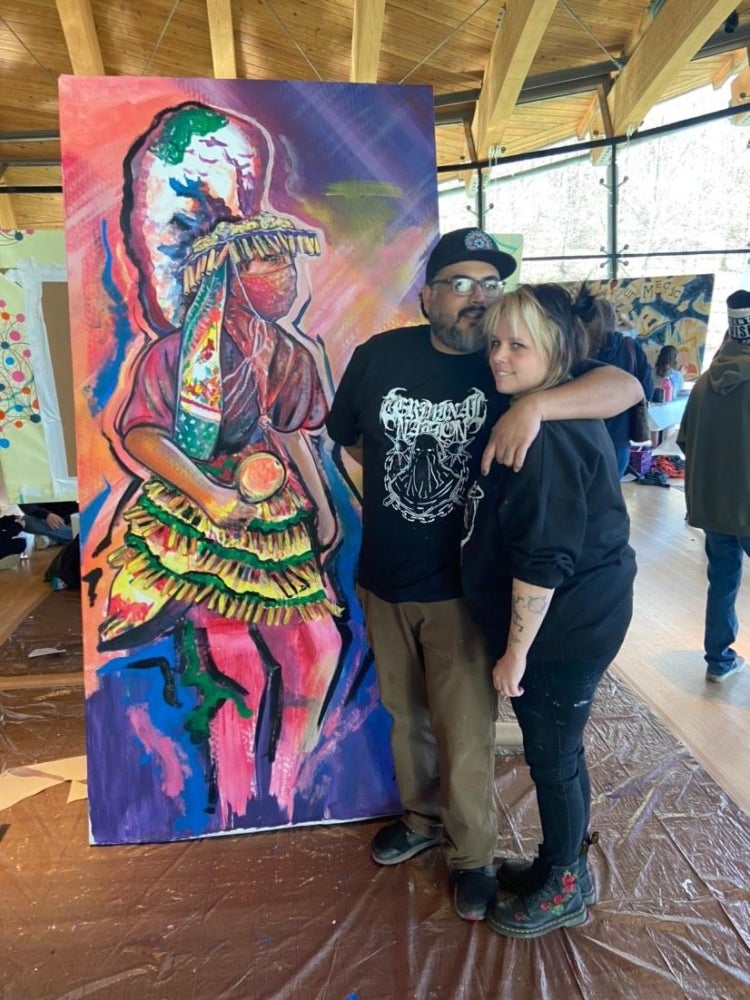
I won’t say the name, but there was a time when I was painting in these two towns. And in the first town, I was painting with a bigger institution. They paid us well, but they didn’t speak much to us. They didn’t give us water or food. I later went and painted a mural in this old market town in Mexico, and they couldn’t pay us monetarily. But they opened their homes to us, they offered us food.
I remember a story this old man told me, and it ended with him taking this well-paid, political job and using that money to fund these grassroots projects he was passionate about. So, take their money; as long as you still are in control of your vision, absolutely take their money. Use it to do the work in your community.
Being a public artist is a responsibility. We’re telling stories. It’s all about telling the stories about our time. No one else is going to, no one is going to read them in books. In 2020, I started the 7th Street Mural Project, because I felt powerless, and I didn’t know what to do. People were dying. I did the only thing I knew how to do. It is a responsibility more than a want or a need even. I love my city. I love this community.
As I leave the space, Jose points me toward the artist’s statement, a brown parchment sheet placed in a green frame just behind the door. It reads:
“With the firm belief that art is a responsibility and not a privilege, art is the reflection of our community, our history, and beliefs. In this way we manifest ourselves, we tell our stories, and spark a dialogue with our community. What we aim to achieve is to visually communicate our presence, a reaction to our situation, our history, to educate and influence those that are not aware, and hopefully gain a better understanding of our society, and of ourselves. Sparking communication through the manipulation of color, perspective, form, and imagination. We are Dedicated, because talent is not enough.”
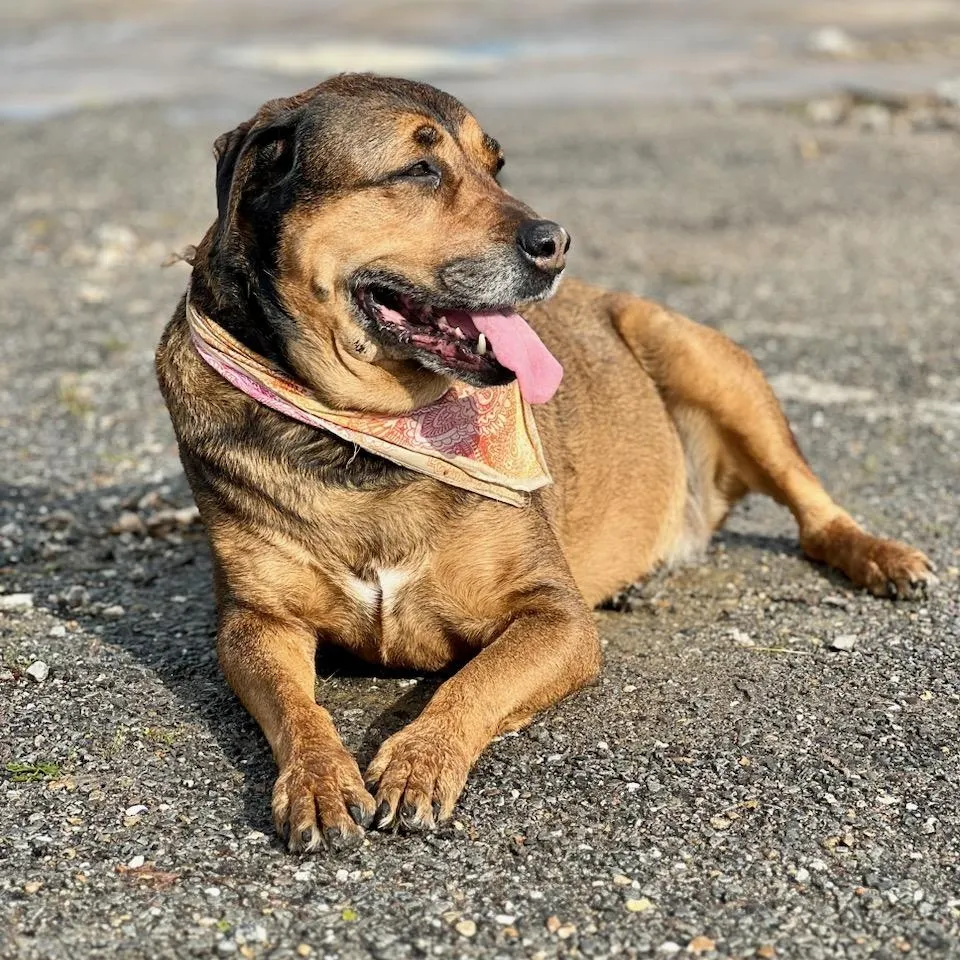
[1] National Weather Service. 2023. “NWS Little Rock, AR – Destructive Tornadoes on March 31, 2023.” National Weather Service. https://www.weather.gov/lzk/svr0323a.htm.




